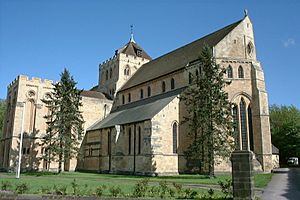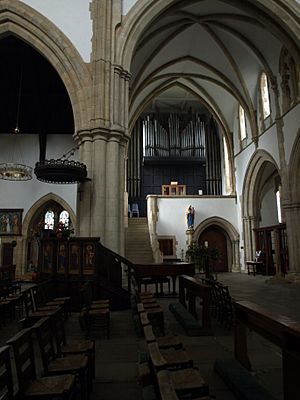St Wilfrid's Church, Harrogate facts for kids
Quick facts for kids St Wilfrid's Church |
|
|---|---|

The church in 2003
|
|
| Lua error in Module:Location_map at line 420: attempt to index field 'wikibase' (a nil value). | |
| OS grid reference | SE 29412 55554 |
| Denomination | Church of England |
| Churchmanship | Traditional Catholic |
| History | |
| Status | Active |
| Dedication | St Wilfrid of Ripon |
| Architecture | |
| Functional status | Parish church |
| Heritage designation | Grade I listed |
| Designated | 4 February 1975 |
| Architect(s) | Temple Moore |
| Years built | 1904–1936 |
| Groundbreaking | 1904 |
| Administration | |
| Parish | St. Wilfrid, Harrogate |
| Deanery | Harrogate |
| Archdeaconry | Archdeaconry of Richmond and Craven |
| Episcopal area | Ripon |
| Diocese | Diocese of Leeds |
| Province | Province of York |
St Wilfrid's Church in Harrogate is a special church in North Yorkshire, England. It belongs to the Church of England. This church is very important because it is a Grade I listed building. This means it is considered a building of exceptional historical and architectural interest. It is the only building in Harrogate with this high honour.
The famous architect Temple Lushington Moore designed the church. It is one of his most well-known buildings. St Wilfrid's is also known as a "Major Parish Church." It is the 38th largest parish church in all of England.
Contents
History of St Wilfrid's Church
Building St Wilfrid's Church began in 1904. This was possible because a large gift of money was left by the Bishop of Ripon. This gift helped start the new church district of St Wilfrid in Harrogate. The church was expected to cost about £24,000 to build.
The first parts of the church, the Nave (the main part where people sit) and the Baptistry (where baptisms happen), were finished in 1908. This part cost £11,000.
Finishing the Church Building
Two sisters, Elizabeth Sophia and Jean Trotter, gave a lot of money to help finish the church. Their first gift of £10,000 helped complete the nave by 1914. The church was officially opened on June 11, 1914, by the Bishop of Ripon. By this time, the original estimated cost of £24,000 had already been spent.
Between 1913 and 1917, special art pieces were added to the nave. These were fifteen painted plaster relief panels. They showed the Stations of the Cross, which are scenes from the story of Jesus. A local artist named Frances Darlington created them.
Temple Moore, the architect, passed away in 1920. However, Jean Trotter left another large gift of £32,000 in 1924. This money allowed the north and south transepts to be finished. Transepts are the parts of a cross-shaped church that stick out on the sides. Temple Moore's son-in-law, Leslie Moore, completed this work in 1927.
Later Additions to the Church
In 1928, a large organ was installed in the north transept. The Bishop of Oxford officially dedicated the organ and the transepts on July 18, 1928.
In 1932, William Gunn left £9,000 in his will. This money helped build the church hall. The hall has a special roof called a lamella roof. This type of roof is very rare in the United Kingdom.
In 1935, Sir William Nicholson helped build the Lady Chapel. This is a smaller chapel often dedicated to the Virgin Mary. His company built it for £10,000. The Calvary, a sculpture of Jesus on the cross, was made by Alfred Southwick. While most of the later work matched Temple Moore's original ideas, Leslie Moore's design for the Lady Chapel was quite different from what his father-in-law had planned.
Music at St Wilfrid's
St Wilfrid's Church has a long history of beautiful music. Since the church was first opened, there has always been a choir. In 2015, a Music Foundation was started. Its goal is to make the music in the church even better and to improve the musical equipment.
The Church Organ
The large Harrison and Harrison organ is in the north transept. It was put in place in 1928 when that part of the church was finished. The organ's basic design came from a sketch by Temple Moore from 1912. Leslie Moore and Harry Harrison made some small changes. Because there wasn't enough money, a proper outer case for the organ was never built.
Arthur Harrison tuned the organ. It is one of the best examples of his work that is still in good condition. Because it is so special, the organ has a Grade II*-listing from the British Institute of Organ Studies.
In 1928, some parts of the organ could not be installed due to a lack of money. Over the years, people have worked to add these missing parts. Additions were made in 1942, 1968, 1972, 1982, and 2011. There are plans to restore the organ completely in the future.
Church Bells
St Wilfrid's Church has eight bells in its central tower. These bells are used for change-ringing, which is a special way of ringing bells in a pattern. The six heaviest bells were installed in 1973. They came from older bells from High Hoyland. The largest bell weighs about 6 hundredweight and 3 pounds and is tuned to C. In 1976, two more bells were added, making a total of eight bells by 1977.
There is also a smaller Sanctus bell in the South-East tower.
Notable Events
The funeral of David Simpson was held at St Wilfrid's Church on January 17, 1931. David Simpson was a very important person in Harrogate. He was a freeman of the town and served as mayor four times.
See also
- Grade I listed buildings in North Yorkshire (district)
- Listed buildings in Harrogate (Harlow Moor Ward)
- List of new churches by Temple Moore



